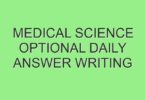Topic:Antipyretics and analgesics, Antibiotics
Question: Describe pharmacotherapy of gout. Describe the rationale of the use of colchicine during attack of gout.
Click here for Reference Material-This material is informational alone and is not specifically prepared as an answer for any question. Readers may do their own research before finalising diagnoses according to the characteristics unique to each question. Readers should not proceed without cross-referencing with relevant textbooks as well as standard guidelines available.
Pharmacotherapy of gout involves the use of medications to relieve acute symptoms and prevent future attacks. The main goals of pharmacotherapy are to reduce inflammation, lower uric acid levels, and prevent joint damage.
- Nonsteroidal anti-inflammatory drugs (NSAIDs): NSAIDs are often the first-line treatment for acute gout attacks. They work by reducing inflammation and pain. Commonly used NSAIDs include ibuprofen, naproxen, and indomethacin.
- Colchicine: Colchicine is an alkaloid derived from the autumn crocus plant. It has been used for centuries to treat gout. Colchicine works by inhibiting the inflammatory response to uric acid crystals. It is often used in combination with NSAIDs or as an alternative for patients who cannot tolerate NSAIDs.
- Corticosteroids: Corticosteroids are powerful anti-inflammatory drugs that can be used to treat acute gout attacks. They can be administered orally, intramuscularly, or intra-articularly. Corticosteroids are often used in patients who cannot tolerate NSAIDs or colchicine.
- Urate-lowering therapy (ULT): ULT is used to lower uric acid levels in the blood and prevent future gout attacks. ULT drugs include xanthine oxidase inhibitors (allopurinol and febuxostat) and uricosuric agents (probenecid and sulfinpyrazone). ULT is usually started after an acute gout attack has resolved and is continued long-term to prevent future attacks.
Rationale for the use of colchicine during attack of gout:
Colchicine is often used during an acute gout attack to relieve pain and inflammation. The exact mechanism of action of colchicine is not fully understood, but it is thought to work by inhibiting the inflammatory response to uric acid crystals.
Colchicine binds to tubulin, a protein involved in the formation of microtubules, which are essential for cell division and movement. By binding to tubulin, colchicine disrupts microtubule formation and inhibits the migration of neutrophils, which are white blood cells that play a key role in the inflammatory response to uric acid crystals.
Colchicine also inhibits the release of inflammatory mediators, such as interleukin-1 beta and tumor necrosis factor-alpha, which contribute to the pain and inflammation associated with gout.








